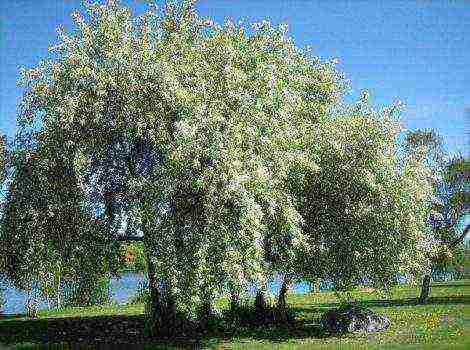Content [show]
Some gardeners manage to make wine from almost every available grape variety. However, the technology of wine production provides for the use of certain varieties of culture, filled with a whole bunch of aromas. The most popular white and blue wine varieties are discussed in this article.
The best wine grape varieties
The grapes from which juices and wine are made are called technical. The characteristic of the bunches looks modest in comparison with the table species:
- medium to small size with densely packed fruits;
- the average weight of the hand is 120-150 grams;
- high content of juice (75-85% of the weight of the berry);
- the sugar content index exceeds 18%.
Wine grapes bear fruit well and consistently. This is facilitated by the increased resistance of plants to fungal infections and pest attacks. Next, we will find out which variety is best suited for winemaking.
The best white varieties for winemaking
Chardonnay
Chardonnay is a world-famous technical grade of Western European origin. It is not possible to thoroughly find out the pedigree, but there is an opinion that the variety appeared thanks to the crossing of Pinot Noir and Gue Blanc.
Berries are processed to produce wines with different flavor notes and fruity aromas. Also, part of the harvest is annually sent for the manufacture of wine materials, which are subsequently used as a champagne flavor enhancer.
Brief characteristics of the plant:
- the bush is medium-sized, although strong-growing lashes are also found;
- the growing season lasts 130-140 days;
- flowers are bisexual, which ensures good pollination;
- conical clusters are loose, weight reaches 900-1000 grams;
- white-green berries are set off with a golden tint;
- fruit shape - rounded slightly elongated;
- grape weight - 12-15 grams, each contains 2-3 seeds;
- sugar content - 18% with an acidity of 8-12 g / l;
- yield - 8-12 t / ha;
- the culture is frost-resistant, withstands temperatures up to minus 20 °.
Chardonnay tolerates drought, with an excess of humid environment, the fruits can rot. Resistance to mildew and powdery mildew is moderate.
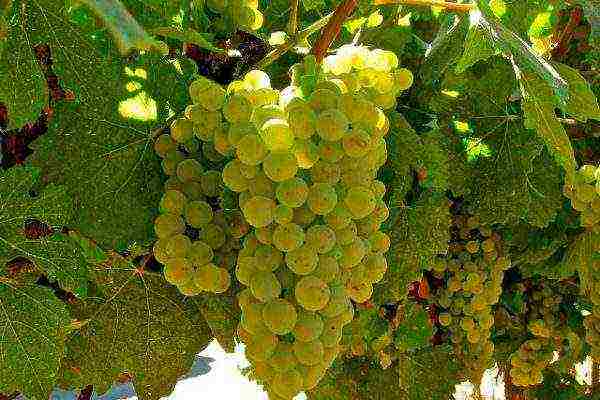 Chardonnay variety
Chardonnay variety
Bianca
Wine material from Bianchi has an unsurpassed taste with notes of vanilla, almonds. For the production of table, semi-sweet and other wines, blending with other juices with a low sugar content is used. This helps to avoid the sweetness that is characteristic of this grape.
The grape was bred in Hungary, the parents are Villars Blanc and Chasselas Bouvier.
Brief characteristics of the plant:
- early ripening, growing season - 110-120 days;
- medium-sized bush;
- cylindrical brushes, weight 90-120 gr .;
- fruits are small and medium, weight 1.5 g .;
- the shape of the berries is round, slightly elongated, the color is greenish-yellow;
- the skin is thin, the taste is harmonious, filled with a bouquet of aromas;
- the crop does not lose its presentation on the vine after the onset of full maturity;
- sugar content - 20-28% with an acidity of 7-9 g / l;
- there is a high resistance to mildew, gray rot, oidium, tolerance to phylloxera;
- frost resistance - up to minus 27 °.
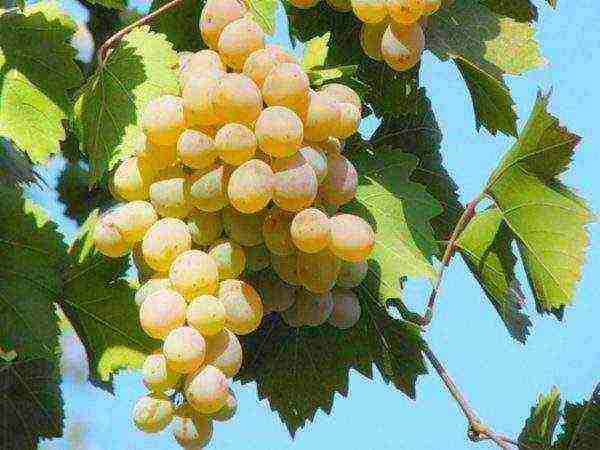 Bianca on the vine does not lose its appearance even after full maturation
Bianca on the vine does not lose its appearance even after full maturation
Muscat
Medium-early ripening muscat with a growing season of 130-140 days. Muscat is one of the oldest varieties originating from Syria, Arabia and Egypt. The peculiarity of the culture is the ability to accumulate a high level of sugar (up to 25% with an acidity of 6.5-7 g / l).
A brief description of:
- medium-sized bush;
- the weight of the conical bunch is 100-450 grams;
- berries sit tightly on the brush, the weight of one is on average 4 grams;
- the taste is full of nutmeg;
- yield - 66-109 c / ha;
- disease resistance is low.
Excellent marketability and taste outweighs poor survival in adverse climatic conditions. Grapes immediately react to a lack of moisture and its excess, is not resistant to low temperatures, and requires potassium dressing.
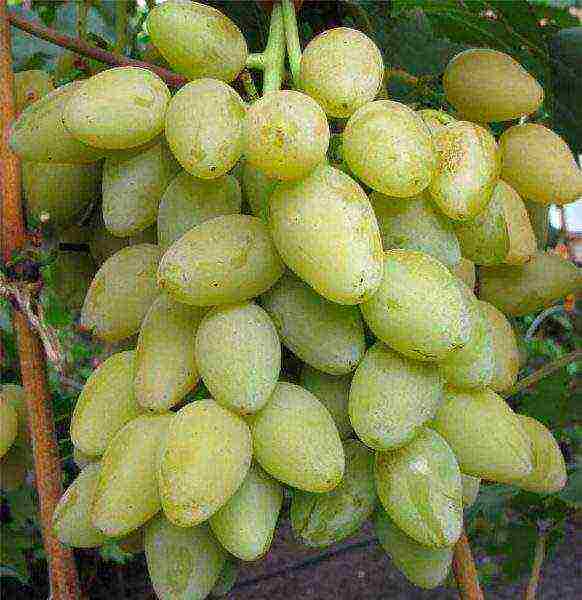 Muscat close up
Muscat close up
Sauvignon Blanc
The variety was obtained by crossing Chenin Blanc and Taminer. Thanks to its excellent taste, balance of sugar and acidity, grapes are recognized all over the world. The peculiarity of the culture is the timely harvest. When overripe, the berry loses its properties and taste, becomes unsuitable for winemaking.
A brief description of:
- growing season 130-135 days;
- bushes are medium-sized, but powerful enough with a developed root system;
- clusters of small size, weight is 75-120 grams;
- the berry is small, the color is greenish-white with a waxy coating (each contains 2-3 seeds);
- low yield;
- sugar content - 18-23% with an acidity of 6.7-11 g / l.
The culture shows weak resistance to powdery mildew and gray mold, tolerance to mildew. In growing conditions with high humidity, shedding of flowers is noted. Soils are preferable with the content of clayey interlayers, as well as gravel and sandy inclusions.
 Sauvignon Blanc - the main thing is not to wait for the berries to ripen so as not to spoil the wine
Sauvignon Blanc - the main thing is not to wait for the berries to ripen so as not to spoil the wine
Riesling
The variety, donated by nature itself, is considered the king in winemaking. High-quality wines are made from berries with excellent taste, which are filled with different notes and shades.
A brief description of:
- growing season - 140-150 days;
- dense clusters, weight 80-100 gr.;
- berries are yellow-green with a bluish tinge, weight 1.3-1.5 g., rounded shape;
- the skin is dense, but thin;
- frost resistance up to minus 20 °;
- full ripening of fruits occurs in October-November;
- sugar content 18% with acidity 9-11 g / l;
- disease resistance is low.
Fruiting grapes on different soils, but land with lime content is more acceptable.
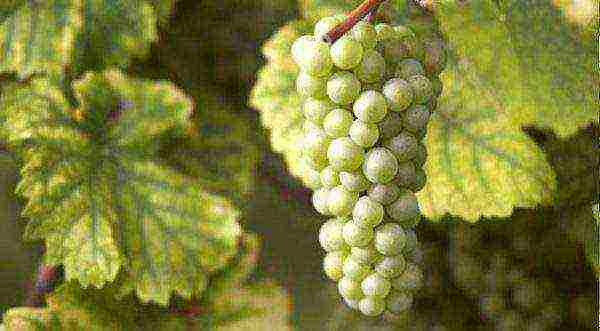 Riesling has low disease resistance
Riesling has low disease resistance
Pinot Blanc
The representative of the Pinot family is characterized by multifaceted taste, it is used to make still, sparkling and dessert wines. Burgundy is the birthplace of the plant, but today almost all European countries and other regions can boast of high yields.
A brief description of:
- growing season - 140-150 days;
- clusters of medium density weighing 85-150 grams;
- berries of a round shape, yellow-green color, weight 1.4-1.7 g;
- the average sugar content reaches 20%.
The peculiarity of the variety lies in the low content of acid and aromatic substances, as a result of which Pinot Blanc is recommended for making wine, which should be consumed by young people.
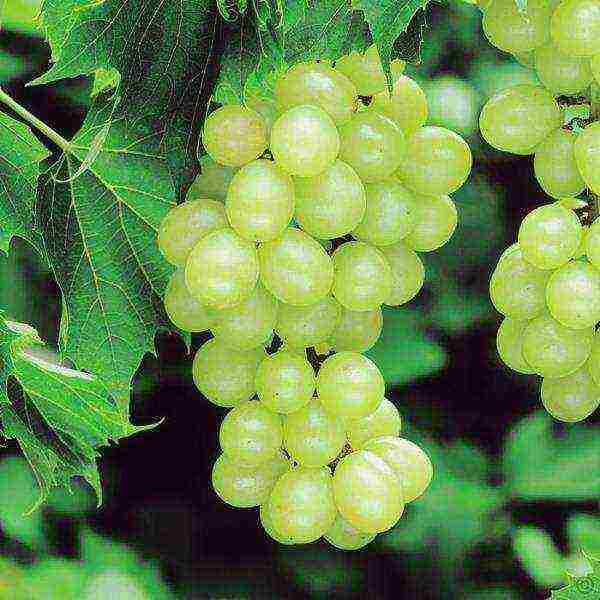 Ripening period Pinot Blanc - 150 days
Ripening period Pinot Blanc - 150 days
What are the best varieties for red wine
Pinot noir
Black fruitful grapes ripen in 141-151 days. There is no reliable information about the origin, but Traminer and Pinot Meunier are considered the likely parents. The bush is medium-sized with an unusual color of the lower leaves (green with a red tint). The flowers are bisexual, there are no problems with pollination. A bunch of small sizes, weighing 66-120 grams, the shape is often cylindrical. The berry has a pleasant taste, colorless juice, balanced sugar content. Its shape is round, the color is dark blue.
The yield of Pinot Noir is 50-60 c / ha. The plant is vulnerable to phylloxera, tolerance to gray rot, powdery mildew is manifested.
Grapes develop poorly on flat and low relief.
 Pinot noir is vulnerable to phylloxera and gray rot
Pinot noir is vulnerable to phylloxera and gray rot
Saperavi
A very old Georgian grape variety with dark blue berries. Saperavi vegetation period is 150-160 days, harvesting begins in late September - early October. The bush is beautifully hung with wide-conical bunches with small grapes, the weight of one is 90-100 gr. The berry is very juicy with a harmonious taste, its weight barely exceeds 1 g. Each contains 2-3 seeds.
The plant has a weak resistance to mildew, oidium, at high humidity it is affected by gray rot. In comparison with other varieties, it is less likely to be damaged by a leafworm.
The yield of Saperavi is 90-110 kg / ha. The culture is frost-resistant, survives the winter without shelter at a temperature not exceeding -20 °.
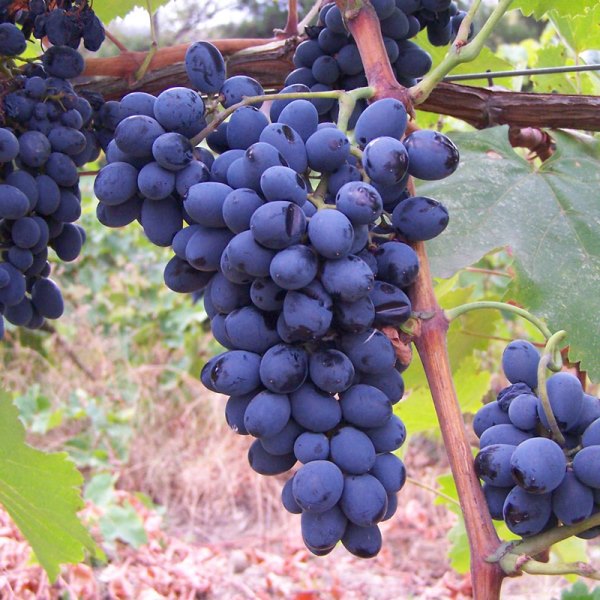 Saperavi is a frost-resistant variety
Saperavi is a frost-resistant variety
Cabernet Sauvignon
Cabernet Sauvignon berries are very juicy with a balanced taste, shaded by a hint of currant. The variety was bred in France, but is now cultivated in many countries of the world. Technical ripeness occurs in 143-165 days. The bunch has the shape of a cylinder, the weight is 70-80 grams. Each berry contains 1-3 seeds. The skin is dark blue in color of medium density, which ensures good preservation and transportability of the fruit.
Productivity - 55-60 c / ha. There is an increased resistance of the culture to mildew and gray rot. In comparison with other varieties, it resists phylloxera, leafworm attacks better.
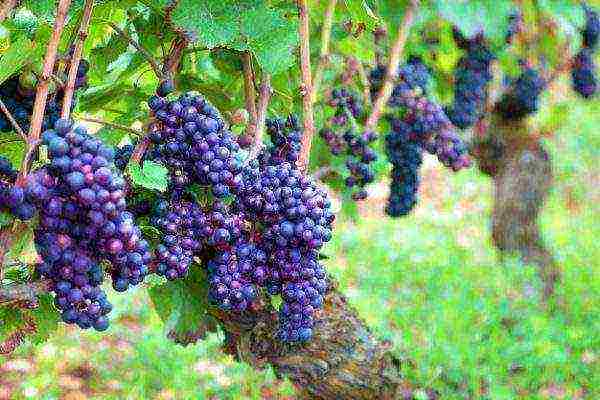 Cabernet Sauvignon is ideal for winemaking
Cabernet Sauvignon is ideal for winemaking
Cabernet Franc
Technical ripeness occurs in 145-160 days. The unusual taste of berries is filled with different notes, in which you can feel raspberries and blackberries. Cylindrical bunches have a dark blue color, the weight does not exceed 70-90 grams. The yield is low (35-40 c / ha), but this is compensated by the good resistance of the plant to mildew, phylloxera.
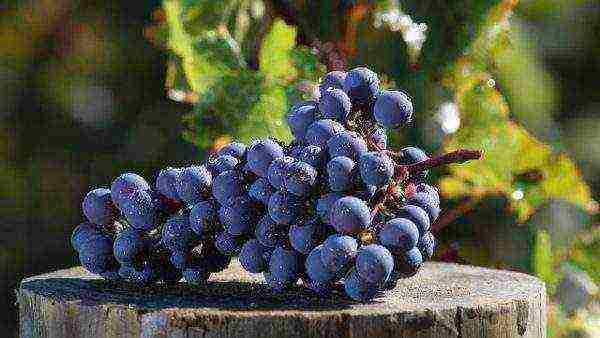 Cabernet Franc variety
Cabernet Franc variety
Merlot
The Merlot variety was bred in France, the intended parents are Cabernet Franc, crossed with Magdalene and Noir de Charente. Bunches of medium size and density, have a dark blue color with a characteristic waxy bloom, weighing 110-150 grams. The taste is balanced with a touch of nightshade.
The grapes ripen in 152-164 days. The plant shows average resistance to powdery mildew, phylloxera, mildew. Frost resistance - up to minus 15-17 °.
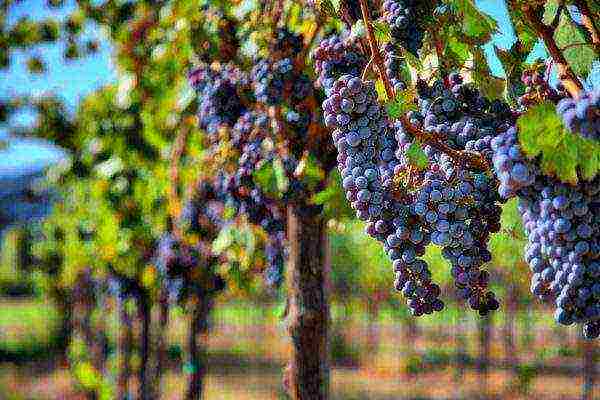 Merlot has medium frost resistance and can withstand temperatures down to -15
Merlot has medium frost resistance and can withstand temperatures down to -15
Sangiovese
Italian thermophilic technical grape with a vegetation period of 145-160 days... The bushes are medium-sized, the flowers are bisexual, the clusters are cylindrical of medium density, weighing up to 100 grams. There are many clones that have slightly different parameters of the berries (0.7 - 1.3 grams).The taste of the fruit, saturated with different notes, adds sophistication to any drink.
 Heat-loving Sangiovese variety
Heat-loving Sangiovese variety
Syrah
The variety is resistant to cold and high temperatures, but does not tolerate strong winds and drought. Taste qualities meet the requirements for technical varieties of grapes, however, it cannot boast of a high yield (30 c / ha). The juice of the fruits of mature plants is saturated with a beautiful dark purple hue and density. Fruit ripening period is 145-158 days. The weight of a broad-conical bunch is within 80-120 gr.
Syrah is very capricious to weather conditions and requires a lot of light and heat.
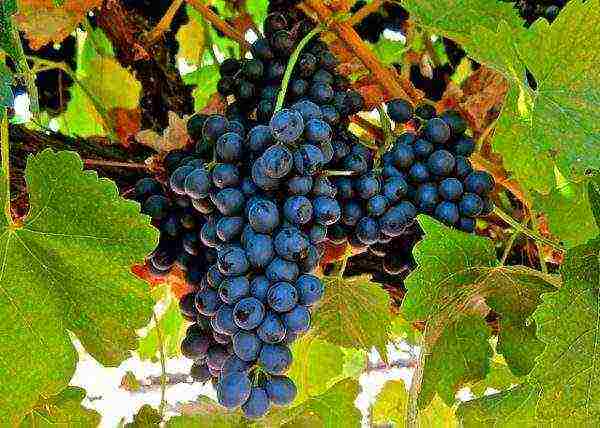 late-ripening Syrah grapes
late-ripening Syrah grapes
Carmenere
The grape belongs to the old French varieties with a growing season of 152-165 days. Currently, it is widely cultivated mainly in Chile, it is considered the pride of the country. The bushes of the plant are vigorous, the bunch can be in the form of a cylinder, wide-conical and shapeless, the weight is 75-100 grams.
A medium-sized berry barely weighs 1 g, but the pulp is very tasty, sweet, but without sugary. The beautiful dark purple color makes it possible to produce wines from pink to dark in color.
Carmenere is very sensitive to weather conditions, cold, shows low resistance to diseases. However, the grapes survived the phylloxer.
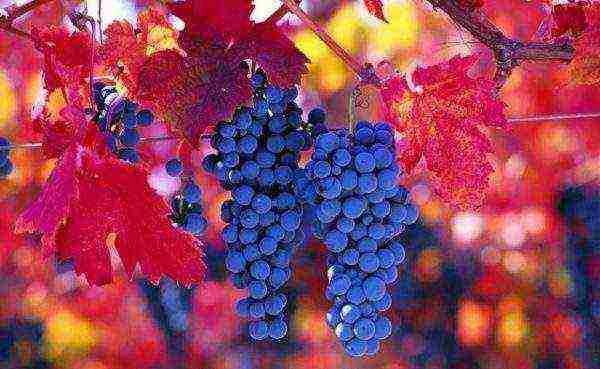 French Carmenere
French Carmenere
Mourvedre
A late-ripening plant native to Spain. The bushes are well developed, have a strong vine and root system. Leaves are medium in size with a characteristic three-lobed shape. Dark blue berries are often rounded, but can take on a slightly oval shape, the parameters are average. Productivity with low watering is up to 60 kg / ha, but with regular irrigation it can significantly increase. The bunches are formed in the form of a cone or cylinder, the berries are tightly pressed against each other.
The culture has a weak resistance to fungal infections, but it tolerates prolonged drought rather tolerably, and high requirements are not imposed on the type of soil when planting.
 Dense Mourvèdre berry
Dense Mourvèdre berry
Grenache
A versatile variety, but most often the fruit is used to make grapes and juice. The variety is one of the most abundant on the planet due to the versatility of the vine. The grapes are very thermophilic, easily tolerate drought and heat. There are also no high requirements for the soil when planting seedlings. Productivity in dry conditions is high - up to 20 kg / ha. Features of berries: low acidity, juiciness, ruby color, rich aroma.
 Drought-resistant Grenache variety
Drought-resistant Grenache variety
Each variety has unique qualities that give the wine a unique shade and aroma. Before choosing a variety, it is necessary to clarify the compatibility of the wine material with juices of other varieties, then at home you can create an exquisite drink, and most importantly - an exclusive one, the taste of which will remain in your memory for a long time.
For modern gardeners of the southern and northern regions of our country and neighboring countries, there are no problems with the choice of grape varieties and varieties due to the variety of dessert and technical types of thermophilic culture. A vine with fruits of different shades and sizes, having a unique taste and aroma, with proper care, allows you to experiment on the garden plot and grow adapted grape hybrids, bred in the last decade by Russian and foreign breeders.
The best dessert grape varieties with a description and a brief description
Growing a decent harvest of early-maturing varieties in the Ural vineyards, in Bashkiria or in Siberia and the Far East used to be a wonder, now it is a common phenomenon, spreading even among inexperienced gardeners. In the southern regions of our country and in Ukraine, mid-season and late table and universal varieties of thermophilic culture are successfully grown.Knowing the peculiarities of agricultural technology, amateur gardeners of the Moscow region and St. Petersburg have learned to grow wine grape varieties intended for open ground, rare dessert varieties of grape vines with specific cultivation features. Most often, novice gardeners do not attach importance to the names of hybrids, preferring to work on "white" and "black" grapes. But knowing the names of species and varieties of grapes with white, dark purple and pink fruits, you can easily understand the agricultural technology of culture and adapt to their characteristics.
The best varieties of white dessert grapes
White-fruited table grapes are good both fresh and processed for compotes and jams. New varieties, developed by breeders, make it possible to obtain large, juicy berries of early and mid-season varieties in the southern regions and in the harsh northern ones. A vine with milky white fruits is a natural phenomenon, the result of a mutation of wild-growing grapes that have lost the ability to produce anthocyanins, which are responsible for the dark color of the berries..
To select the best grape varieties, they are judged according to the following criteria:
- yield;
- quality characteristics of fruits (sugar content and acidity);
- resistance to diseases of the vine;
- frost resistance.
Each person has their own preferences. Sometimes large, beautiful berries of modern breeding varieties with a fresh taste may seem unclaimed and ordinary to someone, these gardeners prefer sweet, but small and loose clusters of raisins. For other grape lovers, not only the qualitative characteristics of the berries are important, but also decorativeness, the adaptation of the vine to certain climatic conditions. There are dozens of the newest varieties, which are still difficult to evaluate, but they are already distinguished by high yields and a bright, rich taste of fruits.... For example, Atlantic, a dessert variety with pink, elongated fruits, juicy and aromatic, with floral-fruity notes; nutmeg variety Silver; Alibaba with harmonious berry taste and black-fruited Carmen; an unusual variety Zephyr with raspberry-pink tassels and a Rostov hybrid Anyuta with the aroma of a tea rose and dense pulp.
Photo Gallery: Latest Grape Hybrids
The leading varieties of white-fruited grapes include:
- Arcadia is an early ripe variety, bred in Ukraine (crossing of Moldova and Cardinal), has dense clusters up to 2 kg. A vigorous plant does not suffer from overload and gives an excellent harvest in central Russia and Siberia, the Urals and the Far East. Ripening period 105-115 days. Berries are light green, with dense, juicy pulp, sweet with moderate nutmeg; 2-3 bones are found. Pruning is carried out for 8-12 buds, processed at least 2 times a season from powdery mildew.

Early ripe grade Arcadia
- Laura (Flora) - a hybrid obtained more than 20 years ago, with light milky oval berries and a pointed tip of the fruit. Crispy, moderately sweet with a pronounced nutmeg aroma. Bunches grow up to 900 g, ripening period - 110-115 days. A medium-sized stem develops well with fan molding, begins to bear fruit for 4 years; trimming for 8-10 eyes. The variety is valued for its frost resistance and for the absence of peeling and cracking of the fruit.

Laura table white grapes
- White kishmish (seedless) is an early ripe variety with round berries, aromatic and juicy. Fruits are light green, when ripe - with a blush. The bunch is loose, large, weighing from 500 to 1200 g. The berry is loved for its balanced composition of sugar and acids, they are excellent for drying, freezing and do not contain seeds. A medium-sized plant finally ripens at 140–160 days. Requires trimming for 7-10 eyes. The variety is cultivated in central Russia and in the south.

The sweetest white grapes White Kishmish
The varieties of Kishmish include the hybrid variety Volodar (early) with large, dense clusters and yellow-green fruits; and Kishmish 342 (Hungarian), obtained as a result of crossing Vilar Blanc and Sidlis Perlet, is an ultra-early variety with elongated fruits of a milky green shade with a tan, sweet and aromatic. The berries retain their presentation for a long time and do not fall off. Varietal varieties of white-fruited grapes of the subspecies kishmish - Zolotse, Talisman (Kesha), Arsenyevsky are considered no less valuable.
Photo gallery: white fruit varieties of dessert grapes
The variety White CoKl of domestic selection, which appeared in the 21st century, firmly tolerates frosts down to -25 ° C and is not damaged by powdery mildew. Powerful bushes are cut into 10 eyes and try not to overload. Then the large, oblong fruits will be sweet and moderately firm. The weight of grape clusters is from 400 to 700 g.
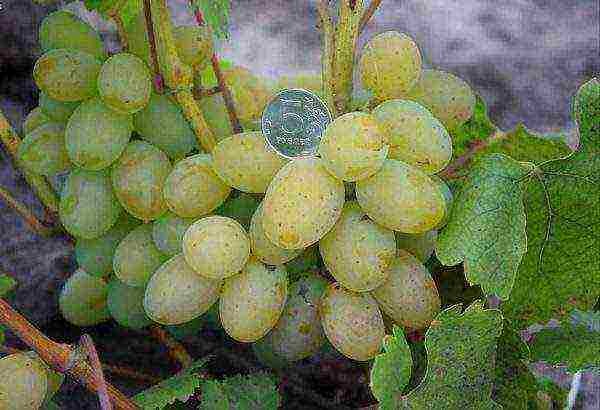
Modern hybrid White Cockle
A hardy and productive variety, Delight quickly takes root and begins to bear fruit in the 4th or 5th year. The early ripening hybrid is thermophilic and responsive to feeding. The result of the gardener's painstaking work will be huge dense clusters weighing 800-1600 g with sweet, large yellow-green berries with a pronounced nutmeg taste. Despite the short pruning, up to 30 kg of the crop is obtained from the bush.
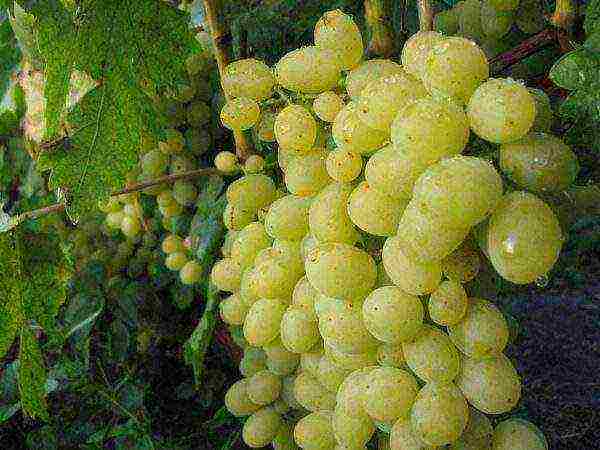
Large-fruited white grapes Delight
In a modern vineyard, Platov's late Jubilee is sure to be met with a harmonious, pleasant taste. For 125–140 days, the bunches grow on average 700 g. The Kostrykin Memory Hybrid became famous for its unpretentiousness and moderate growth of shoots (the vine ripens by 50%). The plant, with a yield of up to 15 kg from one bush, sometimes peas, but is not damaged by wasps and does not require shelter in the middle lane. The average bunch of grapes grows up to 1600 g. Ladies finger with moderate acidity will delight not only with its decorative bunch, but also with delicious fruits. Average weight of brushes - 900 g.
Photo gallery: the best white grapes
The most delicious pink grapes
Hybrid varieties and varieties of pink-fruited vines are attractive in appearance and do not disappoint in taste characteristics. Berries can be from pale pink to deep raspberry shades, so such grapes are often added to wine and canned.
- Early Russian - an unpretentious early ripening variety of dessert grapes ripens at the end of July, loose clusters on average gain up to 600 g. The hybrid grows in the south, the Far East, Bashkiria and Siberia. Light nutmeg with an admixture of caramel aftertaste is loved by every gardener of the middle lane. Rounded, dark pink berries on a tall bush gain sugars - 22%, acids - 7 g / l. 2-3 inflorescences are left on the shoots. The fruit is sometimes cracked and damaged by wasps.
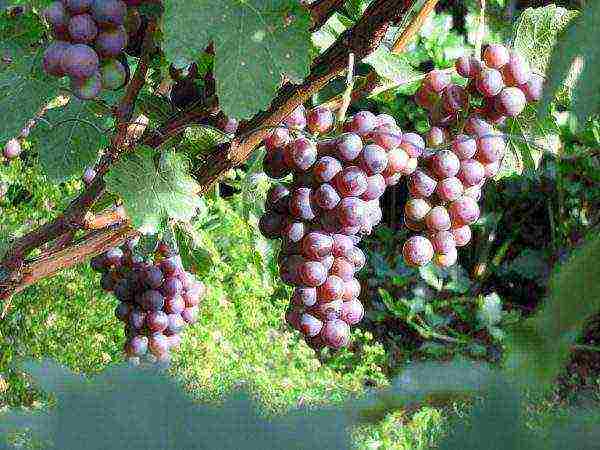
Early Russian grapes grows in many regions of our country
- By crossing Kesha and Rizamat, breeder Kapelyushny bred an ultra-early variety (ripening period of 95 days) Julian, which in less than two decades became popular and fell in love with many winegrowers for its unusual taste and shape. A hybrid with pink, elongated berries, weighing up to 20 g alone, and a powerful vine, grows best in a sunny area; it is cut into 8-10 buds. Juliana's fruits are juicy and moderately sweet, with light fruity notes.

Ultra early grape hybrid Julian
- Tason is an early domestic variety with pale pink, oval, medium-sized berries, crunchy, juicy pulp, with a delicate fruity-honey aroma; the view was developed by specialists of the VNIIViV named after Ya.I. Potapenko. The hybrid is valued for its yield - up to 35 kg per bush with an average bunch - 800 g. Ripening period - 110-120 days. Pruning vines - 10-12 eyes. Be sure to carry out processing from powdery mildew and mildew.

Delicate Muscat of Tason grapes was appreciated by many gardeners in Russia
- Hybrid Transfiguration - these are uniformly colored pale pink, oval berries with a thin skin and juicy pulp. The variety from Krainov's "troika" (Yubiley Novocherkassky, Victor, Preobrazhenie) is loved for its unpretentiousness and a high degree of adaptation to many climatic features. Therefore, the Transfiguration is grown in the conditions of the Siberian summer and in Bashkiria, where the berry has a more intense crimson color. Bisexual flowers are perfectly pollinated. A vigorous plant with regular feeding gives a stable yield - 1–1.5 kg per bunch of grapes, up to 40 kg of selected fruits are harvested from one plant.
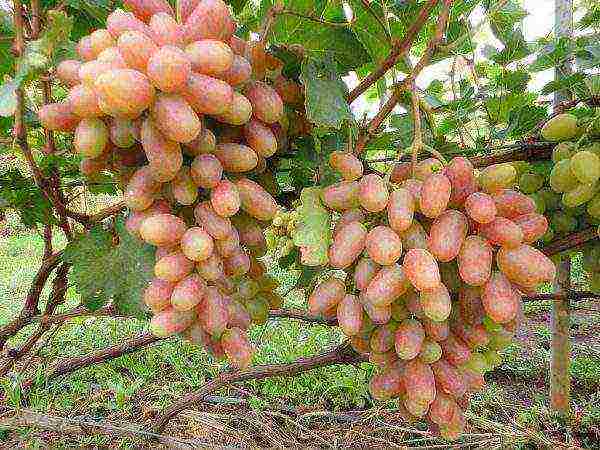
Leader of the "Krainov Troika" - grade Preobrazhenie
- Libya is the brainchild of V.V. Zagorulko, bred in the 90s. The variety is very sweet (sugar content - 26%), aromatic, non-capricious. Peat irrigation and powdery mildew are rare. The berries are oval, pink-purple, with fleshy, nutmeg pulp and thin skin. Ripening period 105 days. The flower is bisexual. Shoots are cut shortly, for 4-6 buds. Among the shortcomings, shedding of ripe fruits and damage by wasps were noted.
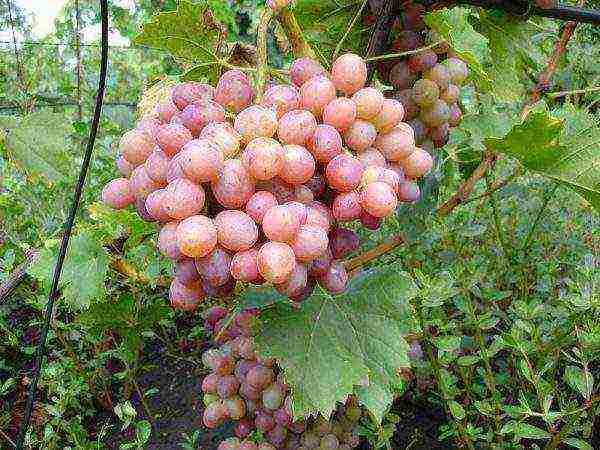
Super early variety Libya
- By crossing Kesha and Rizamat, breeder Kapelyushny bred an ultra-early variety (ripening period of 95 days) Julian, which in less than two decades became popular and fell in love with many winegrowers for its unusual taste and shape. A hybrid with pink, elongated berries, weighing up to 20 g alone, and a powerful vine, grows best in a sunny area; it is cut into 8-10 buds. Juliana's fruits are juicy and moderately sweet, with light fruity notes.
Veles also stands out among the dessert grape varieties. The “parents” of the hybrid are Rusbol and Sofia, amazing in taste and with a stable yield. Veles berries are large, oval, intense pink with a purple tint, the flesh is amber, the skin is moderately dense. There are rudiments in the berries. Veles was appreciated for the muscat-floral aroma of the fruit and the very early ripening period of the first berries - up to 100 days. Vigorous bush, pruning - medium (6-8 buds); sugar content - 23%, acidity - 5 g / l. Covering variety builds up brushes up to 1.8 kg, sometimes more than 2 kg. The fruits are prone to cracking and shedding.
Hybrid Victor from Krainov's "troika" has received attention due to its strong immunity to many diseases of grapes. Winegrowers have long fallen in love with the berries of the variety, which have an unusual shape and with a bright, nutmeg taste and floral notes. Irregularly colored pink-red finger fruits with juicy pulp ripen 110 days from the beginning of the growing season. The average weight of a bunch is 700 g. The yield reaches 10 kg from one grape bush. To obtain a stable harvest, they practice pruning by 4-6 buds and a moderate load during fruit formation. The main advantages of the hybrid form are high sugar content and transportability.
Asian hybrid Rizamat with finger-like, large (15–20 g), violet-red berries, distinguished by large clusters - from 1 kg to 2.2 kg. Ripening period - 125 days. The heat-loving variety is intended for cultivation in the southern regions, the fruits are moderately sweet, with a light nutmeg; the vine is powerful, pruned into 8-10 buds. Despite the usual taste, Rizamat is loved for its high yield and beautiful grape clusters.
Delicate pink, oval berries of the Gourmet variety in the southern latitudes ripen at the end of July, in the middle lane - at the beginning of August. Author's stem V.I. Krainova is powerful, branched, with a yield of up to 10–12 kg per plant. When tasting the fruit, fruity notes and a floral-honey aroma are especially noticeable. The grape variety Rumba of the Rostov breeder Kapelyushny is similar to this hybrid, it ripens even earlier than the Gourmet (Red Delight + Cherrel). GF Rumba is very sweet - 23% sugar, with a share of sourness - 6 g / l. Fragrant, juicy berries are perfectly preserved and are not damaged by insects due to the tart, waxy skin.
On a par with these early ripening hybrids in terms of taste, I would like to add V.V. Zagorulko - Sofia, in which the best qualities of two famous varieties are collected - the large-fruited Arkadia and the unforgettable Kishmish radiant nutmeg. Sofia are large, dense clusters (up to 1.5 kg) with pink-purple conical berries, most often they do not contain seeds.
We love Krainov's pink peach breeding for its frost resistance and mildew resistance. Flowers are bisexual. The grape clusters of the hybrid are loose, grow up to 1.2 kg, berries with a flavor of nutmeg ripen at the end of August. The variety does not tolerate overload and is picky about feeding.With improper care, the berry becomes smaller and sour, but this does not detract from the advantages of a plant that brings a decent harvest equally in Central Russia, the Urals and Udmurtia.
But also one cannot leave aside the varietal flamingo pink grapes, similar in shape and taste to Pink peach - with oval, pinkish-red juicy berries and loose clusters up to 1 kg. A hybrid from Moldova requires pruning for 4-6 buds and does not need shelter for the winter (in the south and in central Russia).
Photo gallery: the best pink-fruited grape varieties
Rose-fruited grapes Arched, like the hybrid form of the Original, are similar in fruit size. Arched ripens at the end of August, berries with light nutmeg contain sugars - 18%, acids - 4–5 g / l; juicy, with floral notes. Original grapes - late variety, fruits are rich in sugars - 22%, moderate acidity - 6 g / l. The pulp is watery, but sweet, with a simple taste. These varietal hybrids are practically not susceptible to peas. Moderately sweet Arched is usually used for wine.
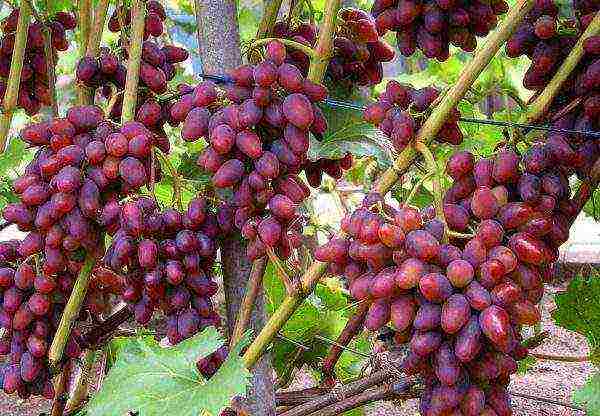
Vigorous variety Arochny
Dense bunches of the Original variety with conical berries and a bright purple color are stored in a cool room for more than 4–5 months.
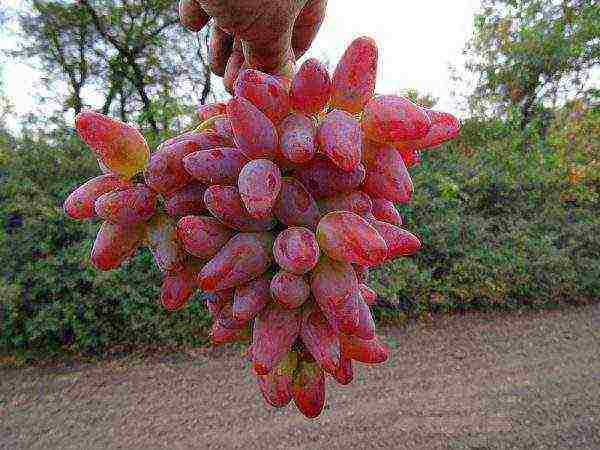
Unusual in shape, tasty and sweet berries of the Original variety are stored for a long time
The best varieties of black dessert grapes
Black-fruited grapes, in comparison with their light-colored "brothers", contain the most monosaccharides and vitamins, are excellent for conservation and winemaking, and seedless varieties are ideal for making raisins and jam. The bright, intense color of the bunches, rich in anthocyanins, serves as a decoration for the garden area.
Most amateur gardeners among dark-fruited grape varieties choose the following modern hybrids.
- Baikonur is an early ripe species - the brainchild of the domestic selection of E.G. Pavlovsky. Dense, voluminous bunches up to 1.2 kg fall on the table at the end of July. The crunchy pulp of dark blue berries with thin nutmeg contains up to 3 seeds, is rich in sugar - 21%. The fruits are able to hang on the bushes for a long time and not crumble. The variety ripens in Udmurtia and Siberia, requires shelter for the winter.
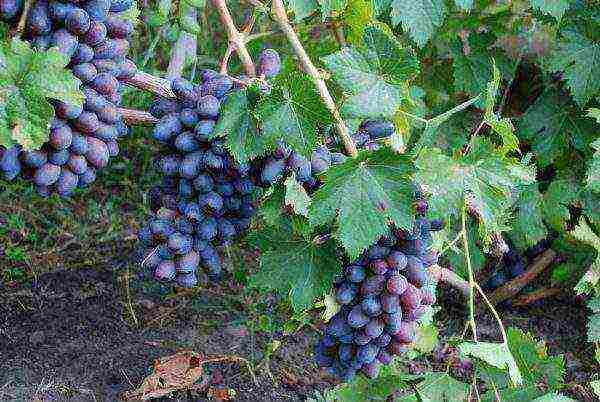
Early ripe Baikonur with blue fruits
- The early variety Codryanka with nutmeg flavor and sweetness is loved by 23% for its abundant fruiting and beautiful clusters. The time-tested variety grows on any soil, provided that the plant is regularly fed, watered and treated against powdery mildew. The weight of the grape clusters is 0.8–1 kg, the berries are dark purple with thin skin. The hybrid is cultivated in most regions of Russia - in the southern regions and in the north, in Transbaikalia and in the Urals.

Dark-fruited hybrid Kodryanka
- The unpretentious Russian hybrid Nadezhda Azos (Moldova + Cardinal) is considered the most delicious black grapes. Dark blue, sweet-sour (sugar - 17%, acid - 7%), the fruits are covered with a thin skin, protection from wasps is required. The delicate nutmeg and juicy flesh justify the rare peas of the hybrid plant. The weight of the bunches is 800 g, the ripening period is 125 days. Pruning for 4-6 buds.
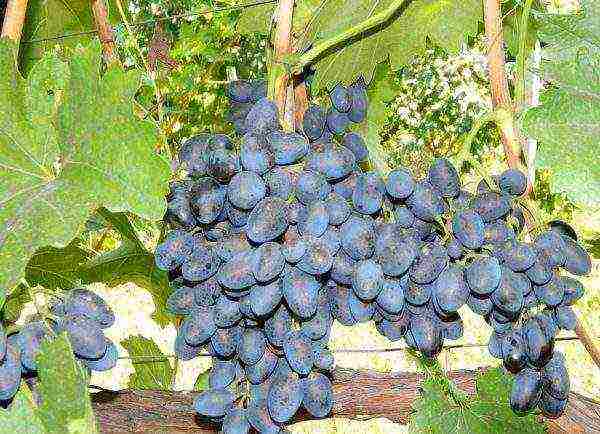
Russian hybrid Nadezhda Azos
- Super early Athos ripens on the 95th day from the beginning of the growing season, the shoots are cut into 7 eyes. A ripe bunch of hybrid forms reaches 1500 g, the variety rarely suffers from insects and powdery mildew. Large blue-black fruits grow on cylindrical bunches, suitable not only for fresh consumption, but also in wines, jams, compotes. The yield of one plant is 15-18 kg.

Frost hardy and drought tolerant, Athos
- Surprisingly large, elongated fruit of grapes Odessa souvenir, received in Ukraine. The berries, blue with a black tint, are covered with a waxy coating and contain 4 seeds. The hybrid ripens in early autumn (brush weight - 0.5–0.8 kg). The berries are distinguished by keeping quality, when overexposed on the bush, they do not crumble. Sugar content - 16%, acidity - 6g / l. Flowers are bisexual. Shoots are cut into 8 eyes. Used in winemaking and homemade preparations.
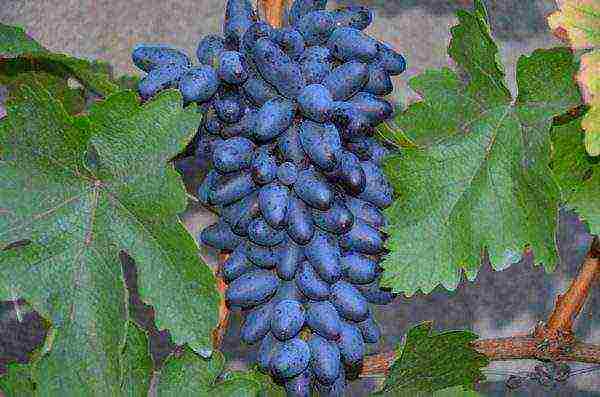
Sweet berries of the Odessa souvenir variety are a little sour and are suitable for making wines and compotes
Among the dark-fruited varieties, some also consider Black Delight (Dolores + Early Russian) the most reliable and productive, which ripens after 110 days. The variety is successfully grown in Siberia and the Far East. A vigorous bush grows on the arches, the brushes are harvested at a weight of 0.6–0.8 g. The Asian variety Black Kishmish (Talisman + Glenora) also earned a high rating among winegrowers. Oval dark blue fruits contain a moderate amount of sugar, they are often used for drying and in compotes. The fruit does not contain seeds. The variety is poorly resistant to mildew infestation. Ekaro 35 is considered the earliest black grape, the berries are purple, round; clusters weigh an average of 400 g. Fruits are rich, sweet, with a specific floral aroma.
Photo gallery: the best black grapes
Black finger is a foreign seedless variety with elongated blue berries with a delicate nutmeg flavor and is appreciated for its impressive fruit size. The heat-loving variety does not tolerate waterlogging, the amount of sugar is 19%, acid is 7 g / l.

Bunch of Hybrid Black Finger
A relatively young American variety Jupiter with an isable taste and pleasant sweetness, they managed to fall in love with their excellent taste (sugar - 21%, acid - 5 g / l), cone-shaped fruits and expressive bunch shape. Trim for 8 eyes. The early ripe hybrid has relatively small (300–500 g) conical clusters. When overripe, the berries soften and lose their taste.
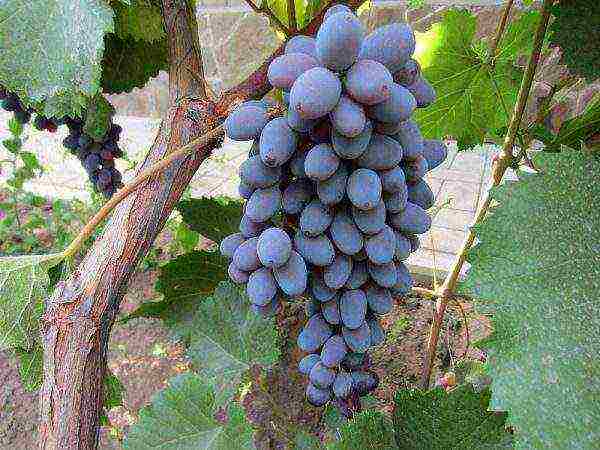
"Overseas" hybrid Jupiter
Black cherry of amateur selection by Vishnevetsky was bred a little over 10 years ago. Among the early varieties, the very first ripens (95–105 days). The weight of the fruit clusters is 400–700 g, the taste is cherry-silk, the flesh is dense and juicy. Berries do not crack, do not crumble; the hybrid is resistant to disease.
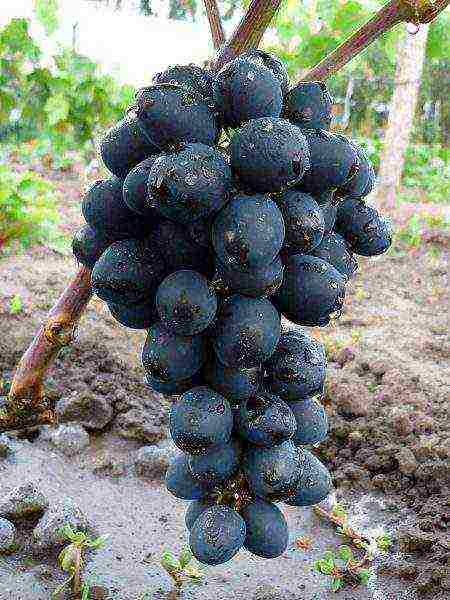
Hybrid Black Cherry
Description and brief characteristics of the best technical (wine) grape varieties
Technical grape varieties, regardless of ripening periods, are raw materials for winemaking... Depending on the intensity of the color and size of the fruit, grapes are used for the preparation of wines and cognac drinks (rose-fruited and black grape varieties more often), for compotes, preserves, jams; for the preparation of raisins, candied fruits, concentrated juices - both white and dark grape varieties.
The most common and widely known table and technical variety is the Isabella grape. Violet-blue, round berries, tightly sitting on a bunch, are distinguished by a high yield - up to 50 kg per bush. Juicy, medium-sized fruits with a specific isable aroma (usually berry-refreshing taste) ripen in 140–160 days. A vigorous bush requires short pruning (5 buds) and a sunny, wind-protected area. In general, the Isabella wine variety is undemanding and resistant to many diseases. 16 -17% - sugar, 5-6 g / l - acid - in the flesh of the Isabella variety. Gives an excellent harvest in Central Russia, the Urals, Udmurtia, Bashkiria.

Technical grade Isabella
Another variety intended for winemaking, Vesta, is appreciated for its excellent wintering without shelter and high yields even in cold, damp summers. Sugar content - 25%, acid - 7 g / l. Blue-violet berries form moderately dense clusters, weighing up to 250 g. The juice is not colored, the pulp is juicy. Pruning for 4 buds. The vine is vigorous. The variety is cultivated for making red table wine.
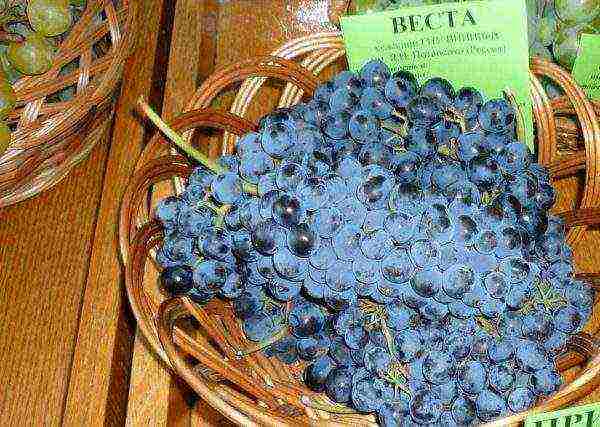
Dense clusters of the Vesta wine variety
Platovsky is a variety of wine and dessert grapes used to make table wines. A hybrid in central Russia and the Far East pleases with an amazing harvest already 115-135 days from the beginning of the growing season. The berries are white with a green tint, round, juicy, small clusters (200 g), very dense. Sugar content - 20%, acidity - 6 g / l.The vine is cut short enough (3-4 eyes), for the winter it is recommended to cover only in the zone of risky agriculture (Siberia, the Far East, the Urals).
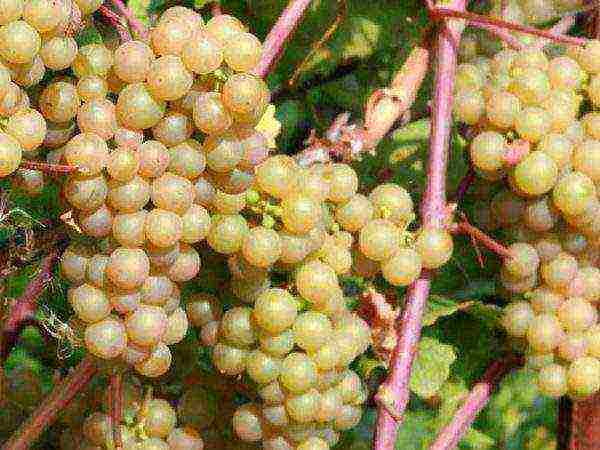
White-fruited technical grape variety Platovsky
Late ripening white-fruited variety The firstborn of Magarach forms clusters up to 200 g, is valued for its harmonious, pleasant taste, delicate skin. The berries are white, round, the brushes are elongated, loose. Sugar - 22%, acid - 8 g / l. The wine from Pervenets is light, with light nutmeg and fruity notes. An erect, powerful bush with an openwork crown is not covered for the winter and is often used as an arbor culture.

White-fruited technical grade Firstborn of Magaracha
Table: qualitative characteristics of some technical grape varieties
Photo gallery: varieties of technical grapes
The finest versatile table grape varieties
Lydia is the most common versatile variety, the juicy, sweet fruits of which with a spicy skin are loved by many gardeners. The vine is obtained from seedlings of the wild growing Vitis labrusca. Thanks to its powerful stem and decorative liana, the isabelle variety has spread not only as a table-technical grape, but also as an ornamental culture. Productivity - up to 25-30 kg per bush. An average bunch weighs about 400 g. Overripe berries crumble and rot, a ripe harvest (after 150–160 days) is ideal for juices and wines.
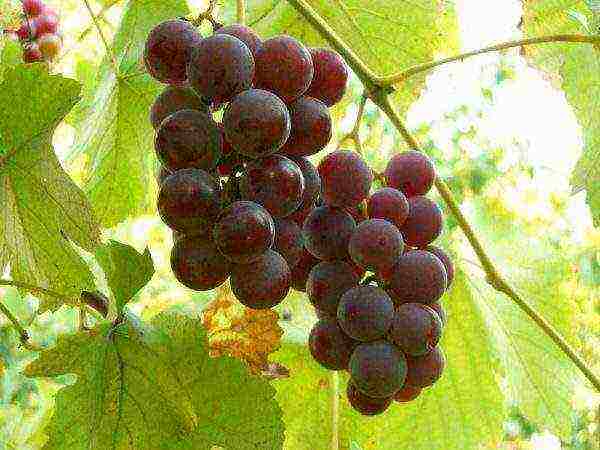
Universal variety Lydia
Hungarian white pearl universal grade suitable for processing and fresh consumption... Amber-yellow, round fruits with subtle nutmeg notes grow on conical clusters. The vine ripens by 80%. Fruit cluster weight - 150-200 g. Pruning - 6-8 buds. Sugar content - 20%, acidity - 7 g / l. A shrub with an average ripening period (120-140 days) is grown in Belarus and Ukraine, in the Urals and Siberia, as well as in central Russia.
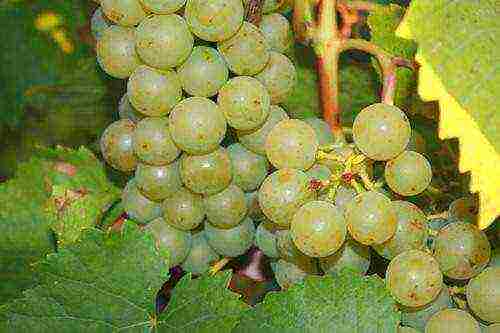
Universal White Pearl
Table-technical grade Black Pearl is a relative of Magarachi, clusters of about 300 g, berries are round, dark blue in color, with sourness and light strawberry nutmeg. Sugar content - 24%, acidity - 6 g / l. Cut grapes for 3-4 eyes, yield in favorable years - up to 15 kg from one bush. A frost-resistant variety of domestic selection was bred in Tula specifically for the production of high-quality dessert wines.
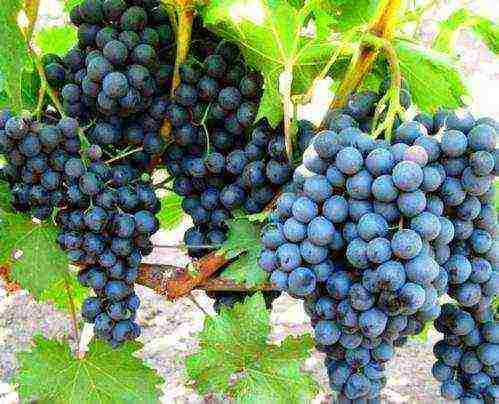
Variety for food and winemaking - Black Pearl
Pink Muscat is a medium-sized table-wine hybrid with bunches of up to 0.2 kg, oval, pink-red berries with a waxy coating. Fruits are fragrant, with floral notes, often used for winemaking, they will be an excellent berry dessert on the table. Average yield - 4-6 kg per bush. The variety is vulnerable to temperature extremes, is affected by powdery mildew and requires fertile soils and fertilizing.

Grape variety Muscat pink
Chassela white, pink and nutmeg is a variety of grapes, which is often referred to as universal varieties. The hybrids are similar in their tasting characteristics, Chassela white (yellow-white, round berries, bunches weighing 190 g) ripens earlier than pink (pink-raspberry fruits with dense skin, brush weight - 250 g); Shasla nutmeg with yellow-green berries has a strawberry flavor, ripens much faster than all varieties of this subspecies. Grapes with sweet, juicy fruits look great on the table and are often highly prized for nutmeg and sugariness when tasting. All types of Chasselas grapes are suitable for wine. Frost-resistant and undemanding grape hybrids are suitable for the zone of risky farming - Moscow region, Petersburg, Bashkiria, Udmurtia, Siberia and the Far East.
Some of the best grape varieties in Russia
There are more than a thousand excellent early, middle and late grape varieties, the purpose of which is the most varied - some are good as a dessert, others for wine and preservation, some table and technical varieties are universal.
Video: the best grape varieties (with a short description)
The best grape varieties for the Moscow region and St. Petersburg
Unstable temperatures, rainy summers in the Moscow region and possible prolonged return frosts - these factors are always taken into account when choosing a grape variety. Therefore, more often in the garden plots near Moscow, early varieties grow - white-fruited Tason, Krasa Severa, Yubiley Novocherkassky, Rusven and the relatively early blue Athos.
In the damp temperate continental climate of St. Petersburg, a fruitful table hybrid in Memory of Dombkovskaya with dark blue fruits, early ripe Laura with large milk-green berries, Alyoshenkin, Harold, Libya, Druzhba are safely cultivated.
Resistant to diseases and low temperatures White maxi are distinguished by white-green large berries with sourness and fruity aroma. Of the technical varieties, gardeners near Moscow and St. Petersburg choose the uncompromising variety Lydia.
Video: the best grape varieties for the Moscow region and St. Petersburg
The best grape varieties for growing in Siberia and the Urals
Siberian gardeners practice the cultivation of frost-resistant early-ripening grape varieties - Tason, Timur, white-fruited Tukai; Rochefort, Super extra, White miracle, Cardinal and Codryanka with purple bunches, Delight, White giant are also popular. For winemaking, no doubt, Isobella and Lydia. The berries of Sharov's selection never fail: Sharova's Muscat and Sharov's Riddle.
Photo gallery: grape varieties for cultivation in Siberia
Video: the best grape varieties for the Urals and Siberia
The best grape varieties in Ukraine
The mild, southern climate and long, hot summers allow growing a variety of varieties of middle, early and late grapes for fresh use, making wine, juices, stewed fruit, candied fruits. Arcadia, Libya, Delight, Julian, Codryanka - ripen in mid-July.Maria Magdalene, Sphinx, Charlie with large dark purple bunches are popular ultra-early varieties; followed by hybrids with light green fruits - Bogatyanovsky, Aramis, Vanyusha, Lancelot, Lyubimy. In early August, the Odessa souvenir, Sigma, Romeo, Strashensky ripen. And at the end of summer, a rich harvest of dessert varieties Zagrava, Sentyabrina, Moldova is harvested; wine hybrids - Rodnichok, Isabella, Alpha.
Photo gallery: the best grape varieties for Ukraine
The best grape varieties in Bashkiria and Udmurtia
The famous hybrids of Sharov, Memory of Dombkovskaya and Korinka Russian are distinguished as the very first for the zone of risky agriculture in Bashkiria and Udmurtia. Super-early and medium-ripening varieties fully ripen and do not suffer from recurrent frosts: Super extra, Alladin, Saratov's Gift, Baikonur, Libya, Monarch. Not uncommon - Radiant Kishmish, Rumba and Early Violet. Working varieties are considered to be fruitful hybrids of Codryanka and Charlie.
Photo gallery: some of the best varieties of Bashkiria and Udmurtia
To prevent the berries from peeling and crumbling in the harsh Bashkir climate, it is imperative to treat the vine with various biostimulants (for example, Gibberellin)
Reviews
Working on new and better varieties, breeders take into account the demand for berry forms and their adaptation rates to different climatic conditions; and the development of winemaking forces amateur gardeners to work on the yield of technical and universal varieties. In any case, the most delicious and harvestable grape hybrids are those that are grown with their own hands on a personal garden plot. If you work tirelessly, even an ordinary universal grape variety will give you berries of amazing taste and aroma that will appeal to any gourmet.
Mena's name is Oksana. By education - an accountant, by vocation - an artist and a mother. I love to travel and appreciate the sincerity and reliability in people. Rate the article:
(1 vote, average: 5 out of 5)
Grape - a healthy culture used for making wine, vinegar, a variety of dishes or fresh consumption. It comes in different types, each of which has its own characteristics. White grape varieties are very popular both for fresh consumption and for the production of wines and other products. You can read about the best varieties, their advantages and disadvantages below in the article.
Features of white grape varieties 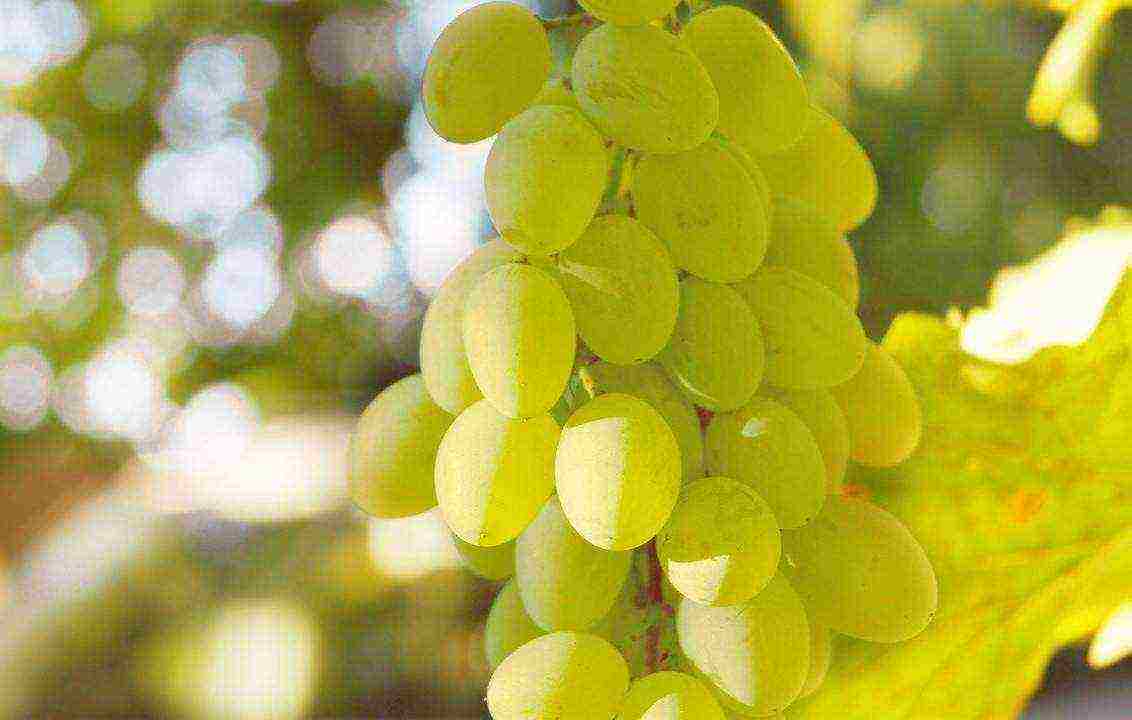
White grape variety
According to international criteria, all varieties with white, yellow or greenish berries are called white grapes, since yellow and green grapes are subspecies of white. It is technical and canteen. The first is used exclusively for processing, the second for food. However, most technical varieties can also be used for food, as table varieties for making wine, but this is rarely practiced.
Interesting!
White grapes are considered the most common in the world. One kilogram of it contains the daily rate of trace elements necessary for a person.
The chemical composition of white grapes is not the same as that of pink, black or red varieties. It contains an abundance of vitamins (A, B, C, E, K, PP), minerals (magnesium, iron, selenium, phosphorus), essential oils, organic acids, antioxidants. Approximate energy value 100 g - 60 kcal. Although this figure can fluctuate significantly, as some white grapes are sweeter while others are sour.
The finest white grapes 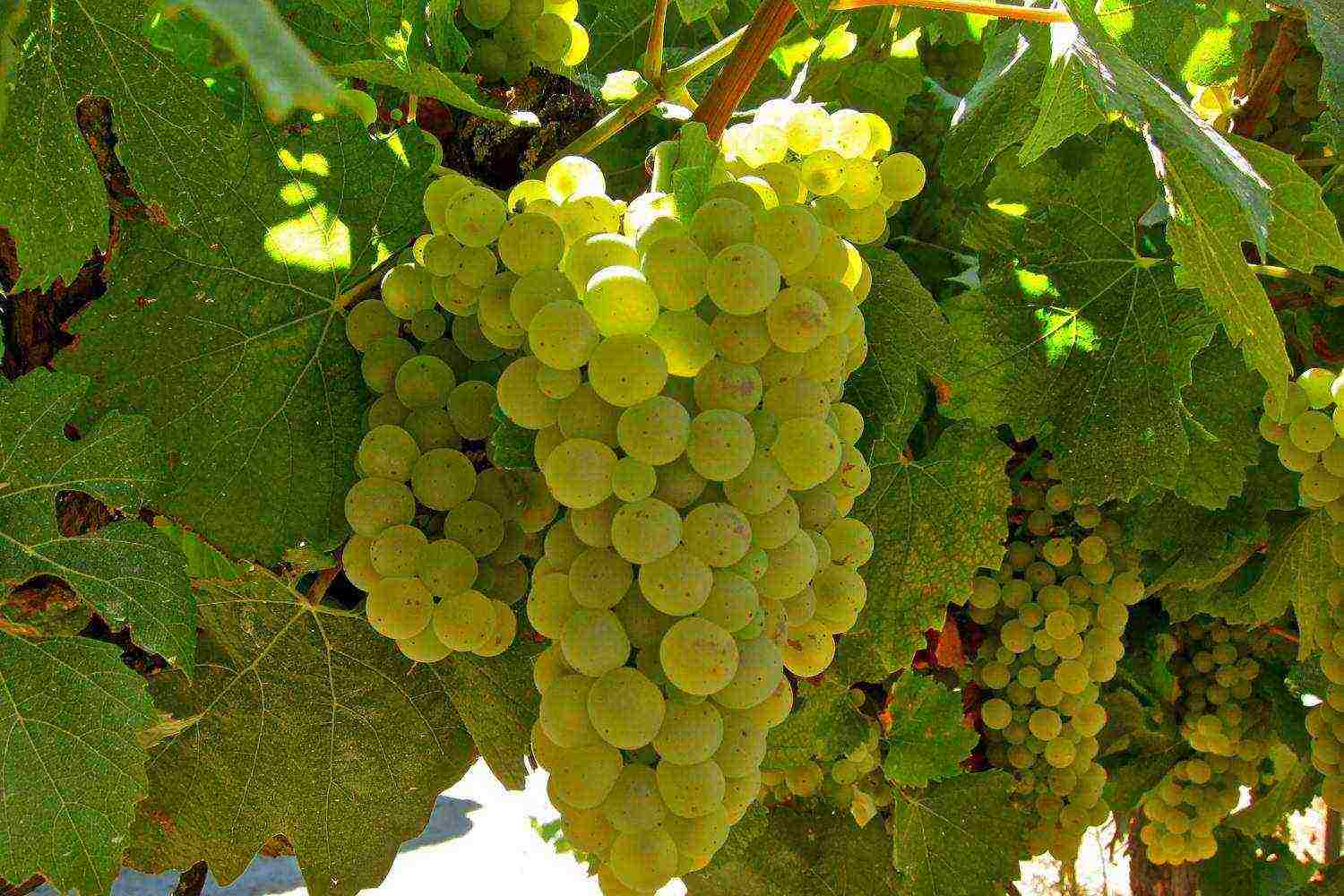
The best varieties of white wine
White grape varieties have over 8000 varieties. Below are the best views that have stood the test of time. Each of them has its own unique qualities, thanks to which they stand out from other species.
- "Arcadia" has another name - "Nastya", but so it is rarely called. It is an early and very common cultivar. The first bunches are removed in mid-July, but only when grown in hot climates. The variety does not need pollination by bees, since it has bisexual flowers. The brushes are tight, large, weighing about 1.5 kg, cylindrical in shape. The berries are oval, with a pointed tip, fleshy, sweet, high in juice and nutmeg aroma. The variety is not afraid of cold weather and frost, unpretentious.
- "Mascot" practically has no flaws, therefore it is included in this category. The only thing that should be noted is that when growing it, additional pollination and rationing of the crop are needed. Otherwise, this mid-early variety is almost perfect. His bunches are large - up to 1100 grams, loose, conical, transportable. The berries are sugary, aromatic. Productivity is high, resistance to frost up to -25 degrees.
Important!
Even a good grape variety in an unfavorable place (on the site) gives poor yields and is often sick. It follows from this that the choice of a place for landing must be approached responsibly!
- "White Muscat" belongs to the best technical varieties of white grapes. He is very popular and valuable. It is used for making juices, dessert and table wines. Productivity 60-100 kg / ha. Bunches are small, 100-450 g, cylindrical. Advantages: high sugar content, aroma. Disadvantages: low immunity, poor frost resistance, peas are possible.
- "Aligote" is a very simple variety, it does not have a pronounced aroma or taste, but it continues to occupy a leading position due to its excellent characteristics for over 300 years. Productivity 90-140 kg / ha. Ripening period - 130 days. Small brush, weighing 100-110 g. Berries are yellow-green, small with brown specks. Advantages: abundance of juice (78%), good chemical composition (for a technical grade). Disadvantages: non-frost-resistant, weak immunity, chokes during long transportation.
- "Chardonnay" - one of the most famous varieties. Ripening period - 138-140 days. The bunches are mostly small, up to 90 grams. The berries are white and green, and can reach 1.6 cm in diameter. Up to 70 quintals of grapes are harvested per hectare. This is not much, hence its increased cost. Pluses: taste, ideal for wine. Disadvantages: poor immunity, low frost resistance, early kidney development.
Table grape varieties with seeds 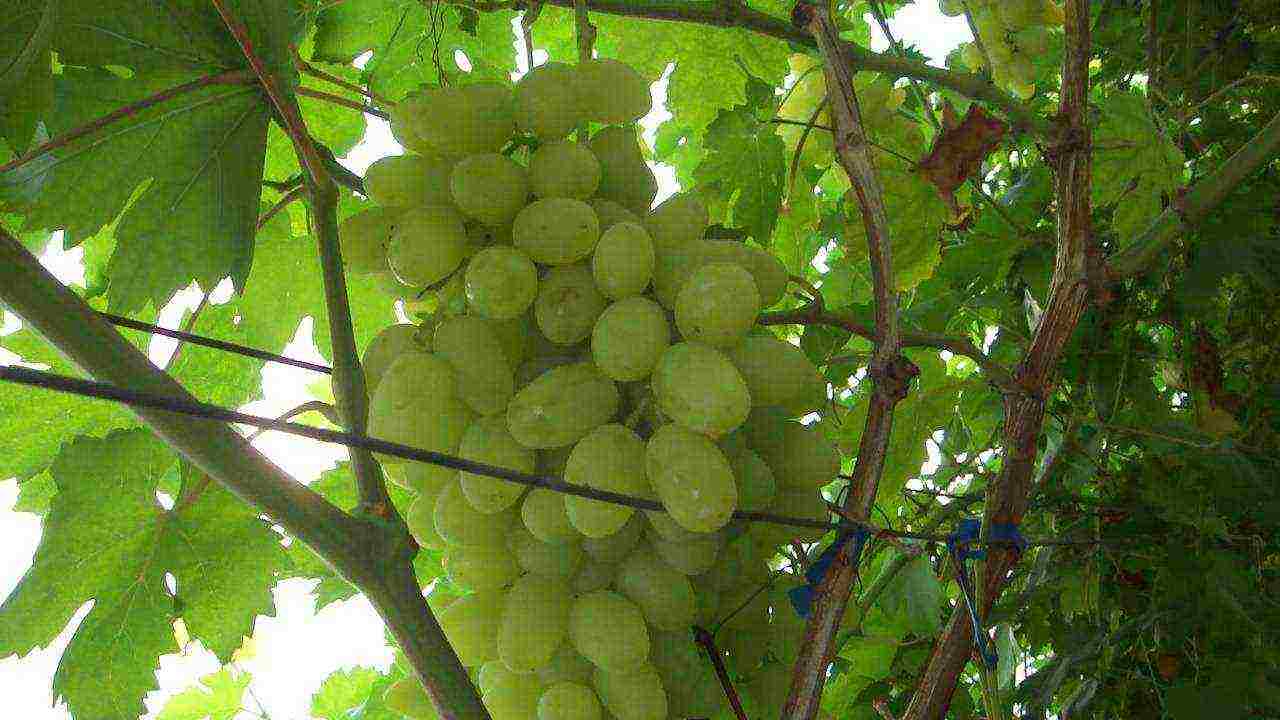
Table varieties of wine
Table white grapes are used for fresh consumption. These are sweet varieties and may or may not be pitted. The taste of the table variety should be pleasant, so not every variety can be classified in this category.
- "CoKl white" an early variety of table grapes, ripens in 125 days. Flowers are bisexual. Medium brushes, about 600 g, cone-shaped. Berries (12-14 g) are oval, light green, with a transparent skin and a slight tan. The taste is delicate, sweet - sugar content 14-18%, acidity 5 g / liter. It has resistance to frost up to -24, strong immunity, but does not tolerate drought.
- "Pleven stable" - early variety. The inflorescences are bisexual. The bunches are loose, large, 500-1000 g. The berries are medium-sized, weighing 8 grams. The pulp is sweet (sugar content up to 20%), juicy, aromatic. 140 centners of grapes are harvested per hectare per season (this is about 60 kg / bush). Advantages: not susceptible to peas, 90% survival rate of seedlings, frost resistance up to -25 degrees, high immunity. Disadvantages: predisposition to certain diseases.
- "Delight white" has large, conical clusters weighing up to 2 kg, ripening in 120 days (early). The berries are fleshy, dense, oval, crunchy when bitten. The skin is tender, easy to chew, but strong, so long-distance transportation of grapes usually does not harm. Productivity 140 kg / ha.Advantages: taste, large berries, yield, high immunity, frost resistance (-26 degrees). Disadvantages: medium rooting rate of cuttings and instability to phylloxera.
Important!
The main disadvantage of almost all table varieties of white grapes is their exactingness to certain climatic conditions and care.
- "White miracle" is one of the most common varieties in Russia and Ukraine, as it can withstand frosts down to -25 degrees without insulation! Maturation takes place over 105-110 days. The bushes are not very tall, the bunches can weigh up to 900 g, not dense. The berries are large, high in sugar and have only two seeds. Does not suffer from oidium, gray rot, mildew. Ripe berries can be stored on the plant for a long time.
- "Tuzlovsky giant" ripens in 115-125 days. The brushes are large, up to 700 g, not dense. The berries are almost round, weighing 7-10 g each, have a waxy film. The pulp is juicy, the taste is harmonious, the aroma is strongly expressed. The main disadvantage is low resistance to frost (-22 degrees), so the vineyard must be insulated.
Also in this category are such famous varieties as: "Pearl Sabo", "New Gift of Zaporozhye", "Bazhena", "Valentina", "Irinka", "Bulgaria", "Elegant", "Beauty of the North" or "Olga".
The best seedless white grapes 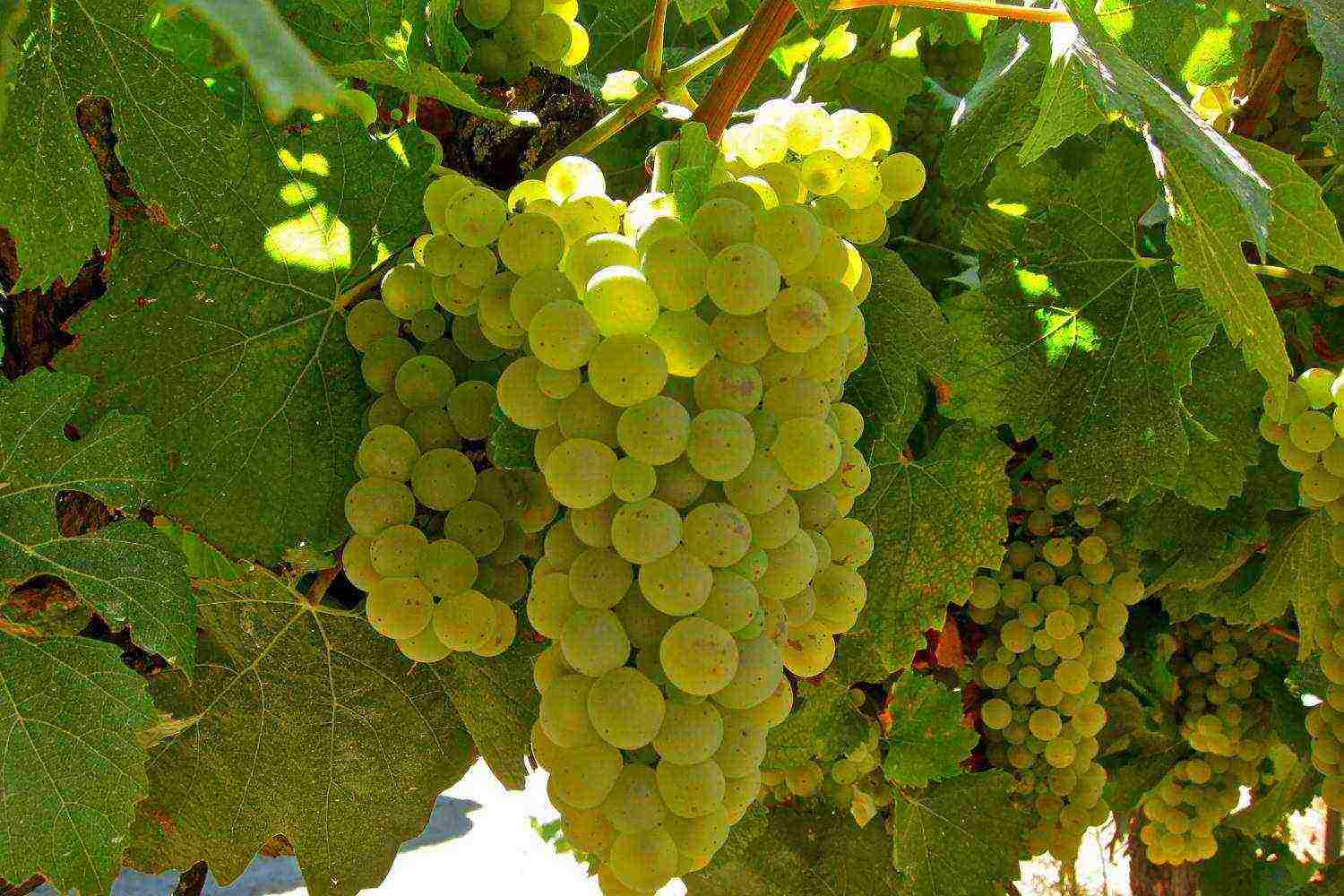
Seedless white grapes
Recently, many varieties of seedless grapes have appeared due to the high demand for them. For the most part, all these white grape varieties are sweet, table grapes, because the very idea of a seedless variety implies the convenience of eating it, not processing it.
- "Lady fingers" or "Husayne" known to almost all people who love grapes. It is a mid-season crop with bisexual flowers. The bunches are loose, medium (400 g), the berries look like an elongated oval, the peel has a light bloom. The pulp is sweet, aromatic, pitted. The main disadvantages: poor immunity to diseases, drought intolerance, low frost resistance.
- "White Kishmish" belong to the best seedless varieties. Despite the fact that nutritionists consider it very dangerous for its high sugar content, the prevalence of this strain is simply incredible. It is loved, bought, grown and consumed both fresh and processed, although it belongs to the table species. It is a mid-season grape with bisexual flowers. Bunches are large, cylindrical, on average 250 g. Berries are medium or small, oval, without seeds. The pulp is tender and sweet, with a pronounced aroma.
- "Century" - seedless table variety, ripening in 140 days. The weight of almost each hand reaches 1.5-2 kg, but sometimes it is less. Berries are oval, weighing 5-10 g, greenish or yellowish color, depending on the degree of ripeness. The taste is delicate, sweet, there is a touch of tea rose and nutmeg aroma. Not afraid of frosts down to -23 degrees. The berries can crumble, so you need to harvest on time.
Technical varieties of white grapes 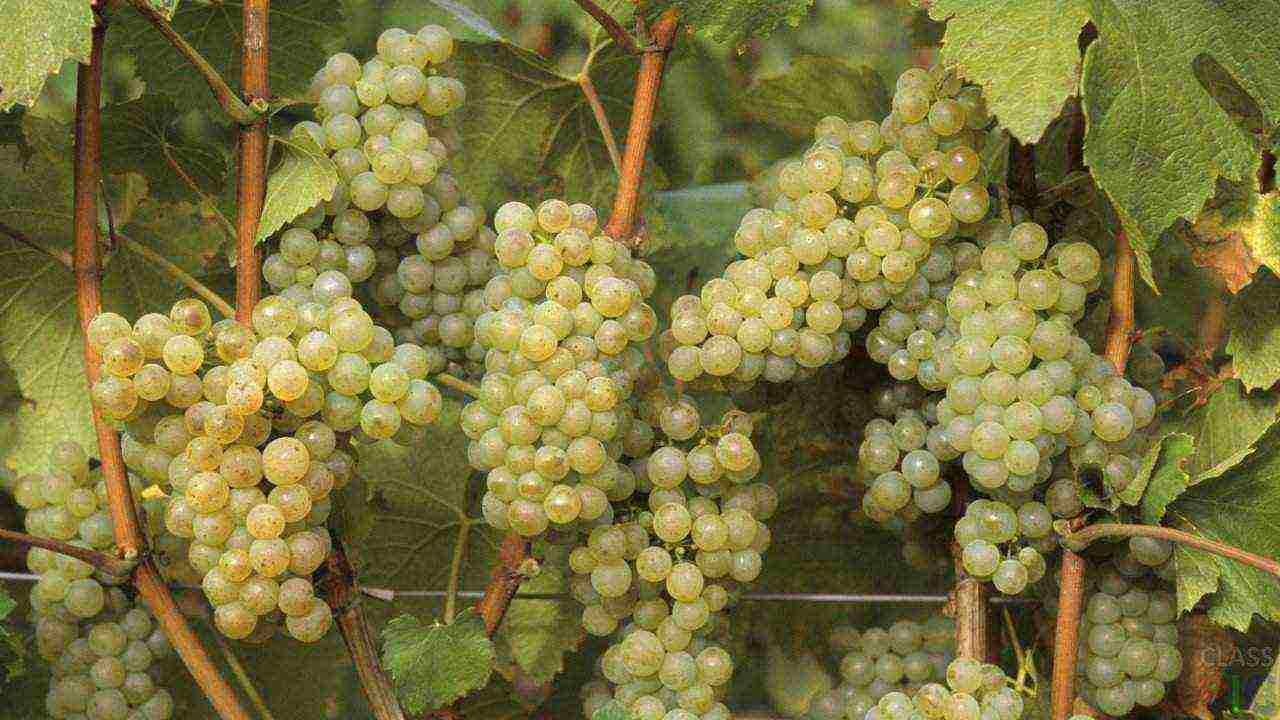
Technical varieties of white grapes
Unlike table varieties, technical white grapes are not used for food, but for processing. They make juices, vinegars, jams, raisins, preserves, but mainly wine.
- "Riesling" has an average ripening period. Bunches are small, weighing 100 g. Berries are small (2-3 g), spherical. The pulp is aromatic, sugar content reaches 22% with an acidity of 6.5-10 g / liter. Frost resistance up to -26 degrees. Disadvantages: affected by powdery mildew. Very refined, delicate wines with a rich bouquet of aromas are obtained from this variety.
- "Crystal" - ripens in 110-115 days. The variety was obtained in Hungary. The brushes are small, weighing 200 g, the berries are almost white, round. Advantages: not affected by gray rot, unpretentious care, if planted correctly, winter-hardy. Disadvantages: weak immunity to powdery mildew, needs proper lighting, can crumble.
Interesting!
The most important requirement for technical grape varieties is large and stable yields.
- "Sylvaner" was bred in Central Europe. Ripens in 140 days. The bunches are small, dense, weighing 90-110 g. The berries are small, spherical, often deformed. The color is light green with an abundance of brown specks. There are few seeds, usually 2, but there may be more (less). The yield is high. Immunity is average, so regular treatment is needed.
This also includes the following varieties: "Müller-Thurgau", "Rkatsiteli", "Pinot Blanc", "Sauvignon", "Semillon".
People began to grow grapes more than six thousand years ago. It comes in two varieties - technical and dining. The first group includes varieties that are used for the manufacture of juices and the production of alcoholic beverages - wines and cognacs, the second group - table species.
What grapes are called table grapes?
Distinctive features of such grapes are beautiful appearance and high taste. Large sweet clusters are eaten fresh, without processing. They tolerate transportation well. The berries have few seeds, thin skin and fleshy flesh. The most popular and elite grape varieties are presented below.
The most popular and best varieties
Arcadia
 Grape variety Arcadia
Grape variety Arcadia
The result of crossing Moldova and Cardinal, combined the successful properties of their parents. Consumers appreciate large bunches that can reach two kilograms, and gardeners appreciate resistance to low temperatures and high immunity. Juicy light pulp of berries captivates with a delicate sweet taste and aroma of nutmeg when fully ripe. This early variety is the leader in yield, if you normalize the number of inflorescences, feed the bush in time. An excess amount of moisture can lead to cracking of ripening Arcadia berries, so watered with caution, taking into account weather conditions.
Delight
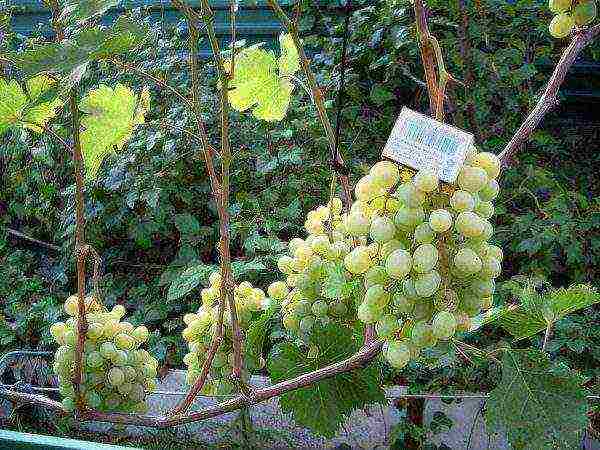 Grape variety Delight
Grape variety Delight
Very early ripening variety. The berries are large, with a refined nutmeg taste and a loose skin with a waxy coating. The vine can withstand temperatures up to 26 ° C frost, therefore, cultivation in the northern regions is allowed. The high immunity of the Delight variety helps fight fungal diseases and mildew, but you need to treat the bush from phylloxera. The yield is high, the fruits can be left on the bush for up to 1.5 months after ripening, while the taste remains excellent.
Experienced gardeners claim that this grape has no drawbacks.
White kishmish
 White Kishmish grapes
White Kishmish grapes
An ancient dessert type with a medium ripening period. The bunches are small. Seedless small oval berries, juicy, very sweet and not tart. Their skin is thin and transparent. Due to their fragility, the fruits are not stored for a long time and have low transportability. After harvesting, they must either be eaten immediately, or used to dry raisins. Dried fruits made from Kishmish are a tasty and healthy delicacy. The vine is powerful, but the yield is low. Average frost resistance. Requires protection from pests and diseases. Needs crop pruning and rationing.
Kesha
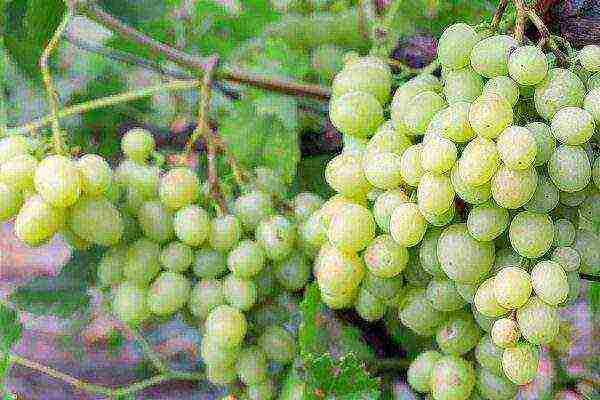 Kesha grape variety
Kesha grape variety
Improved Delight with beautiful brushes. White berries are sweet, with a slight sourness and 2-3 large seeds... Kesha is a medium early variety, very tall, with excellent transportability and frost resistance. It develops well if it has a supply of perennial wood. Will appreciate planting in a sunny place and fertile soil. Moderate watering, thinning bunches, and regular feeding have a beneficial effect on yield.
Strashensky
 Grapes Variety Strashensky
Grapes Variety Strashensky
Handsome man with black berry, medium-early ripening. The fruits are juicy, the grapes are delicious. Bunches of medium density, high-quality type, usually weigh up to 1 kg. Poorly tolerates long-term transportation, average winter hardiness.There is uneven ripening, so the crop is cut selectively. The load on the bush will decrease, the remaining fruits will pick up sugar well. This variety has a reduced resistance to gray mold and powdery mildew, but is good at fighting phylloxera, mildew and spider mites. Needs pruning, depending on the growing region.
Laura
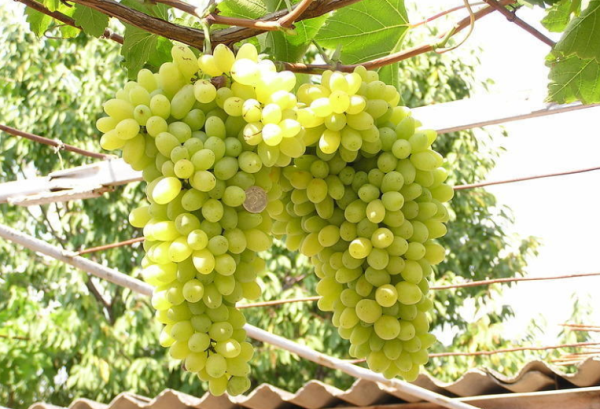 Laura grape variety
Laura grape variety
Table form of grapes of the superearly ripening period. Amber pulp contains a lot of sugar. The taste is rich, pleasant, with nutmeg notes. Large beautiful clusters are a distinctive feature of the variety, some record-breaking brushes weighing up to 2.4 kg. High transportability, popular with buyers and suitable for beginner winegrowers. Resists mildew and gray rot, withstands temperatures up to 20-23 ° C frost. The Laura variety needs pollination during flowering and medium pruning, while preserving perennial wood. The bush is loaded optimally, leaving 30% of non-fruiting shoots. Such a plant will have enough strength to form beautiful large brushes that will ripen on time.
Moldova
 Grape variety Moldova
Grape variety Moldova
A time-tested species, purple berries with a waxy bloom. The bunches are medium in size, the fleshy flesh has a simple taste. Ripening dates are late or medium late. Frost resistance is not very high. Requires careful shaping of the bush - a vigorous vine does not like thickening. Perfectly resists fungal diseases and phylloxera, treatment is needed only against powdery mildew. There is an increased sensitivity to calcareous chlorosis. Used for growing on a gazebo, the bunches retain their decorative appearance and pleasant taste for a long time on the bush. It tolerates transportation well.
Timur
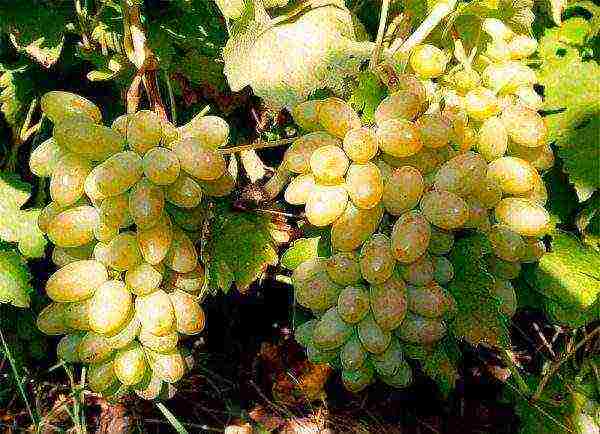 Grape variety Timur
Grape variety Timur
An early ripening hybrid. White berries with a nutmeg aroma, a slight amber or slightly brown tan appears in the sun. The brushes are medium in size, dense. Cuttings give a small "trial" crop already in the second year after planting. High frost resistance and resistance to gray rot and mildew. Timur grapes often fall prey to ticks. If the leaves "swell" and redness appears, you need to treat the grapes with a sulfur-containing preparation. Experienced growers praise Timur for the ease of cultivation and early maturation. Care consists in regular watering, feeding and pruning.
Lady fingers
 Grape variety Ladies fingers
Grape variety Ladies fingers
An old mid-season variety that, despite the difficulties in its care, continues to be grown by many growers. The weight of one hand is about half a kilogram. Berries of the Ladies' fingers are elongated in shape, with a classic harmonious taste and mouth-watering aroma, pitted. Not resistant to low temperatures, can die already at 10 ° C frost, therefore needs shelter for the winter. Productivity is changeable, depending on weather conditions. The vine is sensitive to diseases and pests; regular treatment with appropriate preparations is necessary. Recommended for experienced gardeners.
Gourmets consider this variety to be the standard of grape taste.
Mascot
 Grape variety Talisman
Grape variety Talisman
Medium early grapes are yellow-white in color. Vigorous seedlings are excellent resistance to mildew and gray rot, resistant to low winter temperatures. Ripe bunches weigh a little more than a kilogram on average. The fruits are large, with a nutmeg aroma. Already ripe brushes can hang on the bush for a long time without losing their taste and retaining their marketable appearance. A transportable variety that does not require shelter for the winter. A record harvest can be achieved with proper agricultural technology and additional pollination before flowering.
Grapes are a wonderful gift of nature, a child of the gentle sun and fertile land. There are no ideal varieties, but you can always find a species that suits the growing conditions and personal preferences of the gardener.

